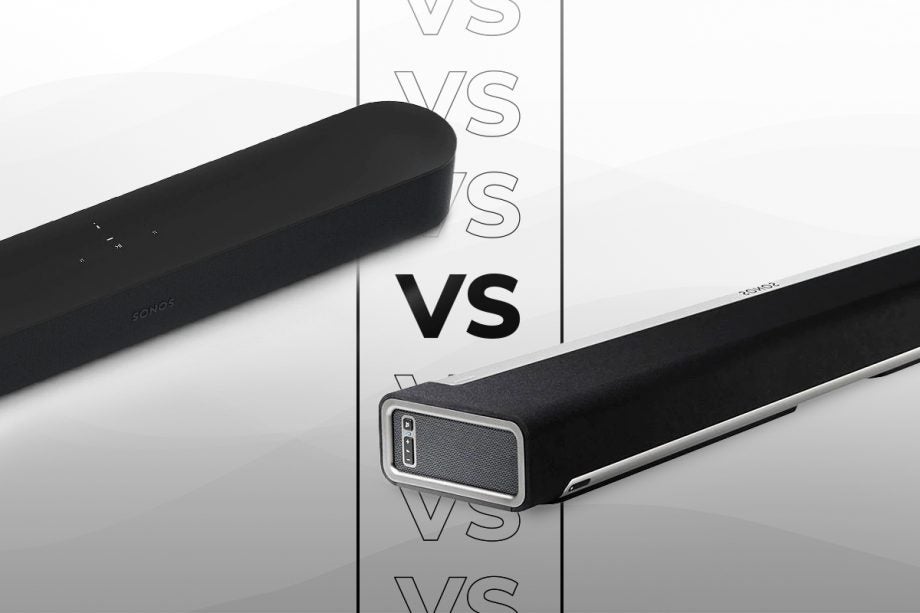Sonos Beam vs Sonos Playbar: Which is better?

So you’ve decided you want a soundbar in the Sonos system, but which of the two models should you opt for out of the Sonos Beam vs Sonos Playbar?
The baby of the duo, the Beam comes with Alexa smarts and an compact design, not to mention a lower price tag. But does the larger sound of the Playbar make the extra outlay worth it?
Related: Best Soundbars
Sonos Beam vs Sonos Playbar – Design
The Sonos Beam takes an early lead thanks to its newer, more modern Sonos design.
It’s available in white or black, and offers touch controls along its top panel. The Playbar comes in only a single black and silver finish and relies on physical buttons awkwardly placed on its side. It isn’t particularly attractive, and looks far more functional than its stylish sibling.
The Beam’s lines are also much sleeker, with softly curved edges and a much slimmer profile. Measuring 65cm long, 6.5cm tall and 10cm deep, the stylish Beam should slip under most TVs with ease.
The Playbar, on the other hand, is likely to require its own shelf on your TV stand, if you don’t want it to lop off the very bottom of your TV’s picture with its 90 x 8.5 x 14cm frame. It’s heavier, too, weighing in at 5.4kg to the Beam’s 2.8kg – something for potential wall-mounters to consider.
As for placement, the Sonos Beam has been designed to be used in one orientation only, whereas the Playbar has angled drivers that allow it be used in both flat and upright positions, without any sound degradations. In terms of design, there’s only one winner: Beam.
Sonos Beam vs Sonos Playbar – Features
Being Sonos speakers, both the Beam and the Playbar offer all the same multi-room streaming smarts as the rest of the Sonos family.
As such, it’s possible to use both soundbars in a multi-room set up with any other Sonos speaker, streaming music from more than 60 streaming services – be it the same or different tracks – directly from the Sonos app.
However, the Sonos Beam takes the smart side of stuff a little further with built-in Alexa and Google Assistant support, which allows the unit to double up as a fully fledged smart speaker too.
This provides access to a whole world of Alexa voice control, including the ability to ask Alexa to turn on your TV and control what’s playing on any connected Fire TV device.
The Playbar isn’t entirely left behind here, though. If you have an Echo or an Echo Dot, you can download the Sonos skill and use it to control the Playbar with your voice – it just isn’t as smooth and straightforward as the Beam’s integrated experience.
The Sonos Beam also brags Apple AirPlay 2 compatibility, which will allow playback on the Beam to be controlled via Siri. This also opens it up to be paired with other, non-Sonos AirPlay 2-compatible speakers – such as a Naim Mu-So or an Apple HomePod – in a simple multiroom setup.
As a result, the Beam is much more flexible than the Playbar when it comes to functionality – although, unless you’re an Apple Music user, the music you play between AirPlay 2 speakers will have to be the same.
Away from the smart stuff, both speakers can be combined with a Sonos sub for more oomph, and even with two extra speakers such as the Play:1 for full 5.1 surround sound.
They also both pack Sonos’ clever TruePlay technology (iOS), which allow the speakers to have their sound tweaked to your room by running an automatic calibration programme to judge its environment.
With its more current and wider range of features, the Beam takes another win.
Beam vs Playbar – Specification
While it’s an easy win for the Beam in the looks and features, it’s also better equipped when it comes to practicalities as well.
It offers an HDMI ARC (audio return channel) connection for hooking it up to your TV, as well as an optical input, with the Playbar only offers the latter.
This means the Beam has the ability to support HDMI CEC (Consumer Electronics Control), which allows you to control the TV and soundbar as one unit, rather than the two acting independently. This is particularly important for voice control, and we’ll go into that in more detail below.
However, in order to accommodate HDMI, the Beam does drop one of its ethernet ports, which the Playbar retains. This would be important for anyone needing to hardwire their soundbar to their router, or a Sonos sub.
As for audio components, it’s little surprise that the Sonos Beam can’t pack in the same driver array as the larger Sonos Playbar. While the Beam manages to squeeze eight drivers into its petite frame, the Sonos Playbar has nine.
Just the one extra driver might not seem much more for all that extra bulk. However, it’s less about quantity of drivers here, and more about what they are and how they’re powered that really counts.
In the Beam, you’ll find four full-range woofers, one tweeter and three passive radiators supported by five class-D amplifiers, while in the Playbar there are nine drivers, each individually amplified and made up of six mid-range woofers with three tweeters.
Each has its pros and cons when it comes to their specification, so we’ll call this one a draw.
Beam vs Playbar – Performance
The Sonos Playbar is armed with more power and a greater number of drivers, and it’s in this department that the Sonos Beam hits trouble.
Clearly, the Playbar offers greater power and depth of sound. If you want your blockbuster soundtracks to shake the room and have impact, the Beam can’t compete.
This is more apparent in larger rooms, which the Beam struggles to fill. It’s fine in smaller rooms, however. The Beam also does what it can to make up for its shortcomings by placing an angled woofer at either end to help disperse its sound wider.
With more power and drivers, that makes it an easy win for the Playbar.
Sonos Beam vs Sonos Playbar – Verdict
One of the most attractive things about the Sonos Beam is the price. At £399, it does plenty for the money, and even though the Playbar ultimately sounds better, it costs a bit more.
If you’re looking for the very best in sound, or have a particularly large room, the Playbar’s extra cost will be worth the outlay. But for most, the Sonos Beam will do just fine, offering better features and leaving your bank balance looking much healthier in the process.


